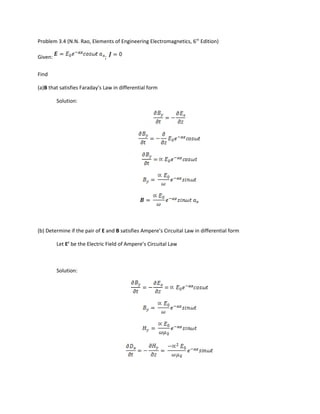Problem 3.4 (Rao): Faraday's and Ampere's Laws for E and B Fields
•Download as DOC, PDF•
0 likes•231 views
This document solves two problems regarding Faraday's and Ampere's laws of electromagnetism. It first finds the magnetic field B that satisfies Faraday's law given an electric field E. It then determines if the same E and B fields satisfy Ampere's law by checking if their electric fields are equal, finding they are not, so the pair do not satisfy both laws.
Report
Share
Report
Share

More Related Content
What's hot
What's hot (20)
Viewers also liked
Viewers also liked (6)
Advanced semiconductor fundamentals__se__robert_f._pierret

Advanced semiconductor fundamentals__se__robert_f._pierret
Physics of semiconductor devices S. M. Sze Kwok K. NG Second Edition

Physics of semiconductor devices S. M. Sze Kwok K. NG Second Edition
AM modulation and Demodulation with Circuit and Output

AM modulation and Demodulation with Circuit and Output
Problem 3.4 (Rao): Faraday's and Ampere's Laws for E and B Fields
- 1. Problem 3.4 (N.N. Rao, Elements of Engineering Electromagnetics, 6th Edition) Given: ; Find (a)B that satisfies Faraday’s Law in differential form Solution: (b) Determine if the pair of E and B satisfies Ampere’s Circuital Law in differential form Let E’ be the Electric Field of Ampere’s Circuital Law Solution:
- 2. Since the electric fields are not equal, . The pair of fields E and B satisfies only Faraday’s Law, while the pair E’ and B satisfies only Ampere’s Circuital Law. Thus, the answer is no.
